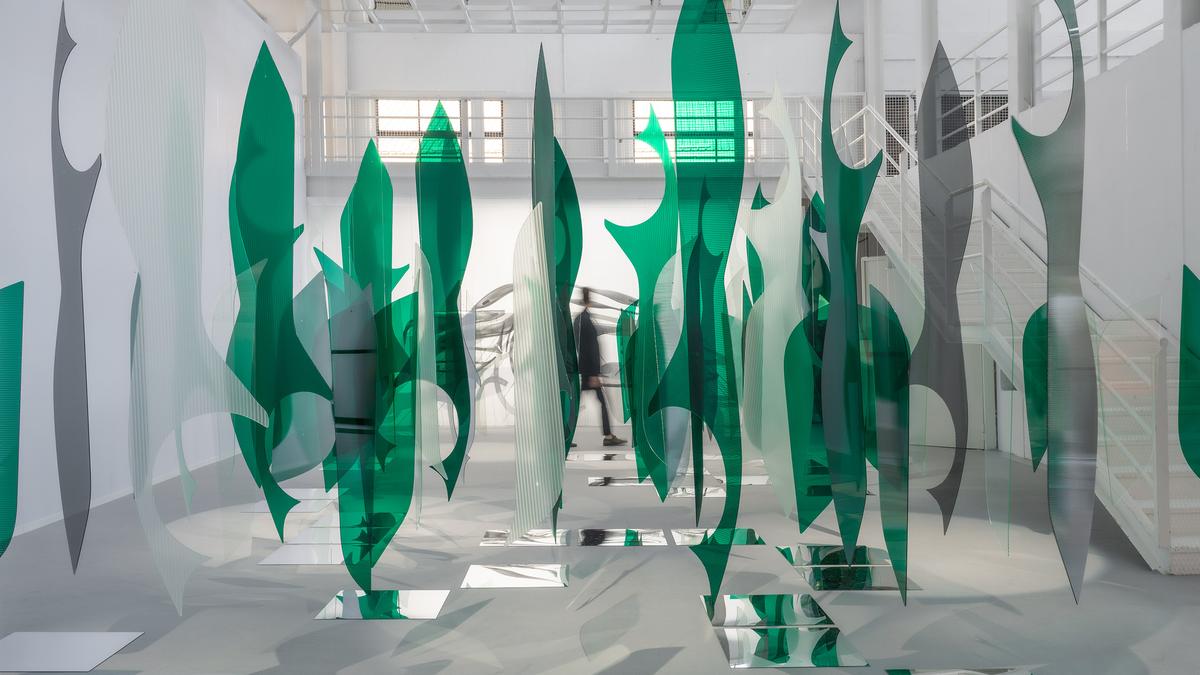When the Humboldt Forum opened in 2021, it was met with excitement and quite a lot of controversy. The latter because the newest addition to Berlin’s already impressive ensemble of museums is a testament to colonial acquisitions — with over 20,000 objects in their vast collection taken (more often than not, forcibly) during a time of European expansion. Think Nataraja bronzes from the Chola era, delicate Ming-era porcelain, an intricately beaded Mandu Yenu throne from Cameroon, and ivory tools from Namibia.

A Nataraja statue from South India on display at the Humboldt Forum | Photo Credit: Getty Images
Over the last four years, however, it has become a more collaborative project, states professor Lars-Christian Koch. “This means that we are inviting international experts and source communities to work with our collections, in our museum storage and in exhibitions. And we are working together in provenance research to find out where these objects came from and what they mean to the people [who originally owned them],” he says.
Humboldt Forum contains two formal museums: the Ethnological Museum and the Museum of Asian Art. The intention of the site, shares Koch, who represents the State Museum of Berlin at the Forum, is to surprise, provoke and hopefully initiate dialogue and discourse on the contents of the museum.
Confronting colonialism’s crimes
The exhibits are fascinating and eclectic but raise the question: whose art is it? Who do these artefacts belong to? These are pertinent questions that prestigious museums such as The Metropolitan Museum of Art in New York and the British Museum in London have continually chosen to ignore or brush aside — claiming that their collections were either bought legally from private collectors or “gifted” by local rulers to their colonial masters. But given the inherent power imbalance at play, the idea of any kind of treasure being handed over voluntarily by the subjugated is ludicrous.

A Benin bronze at Humboldt Forum | Photo Credit: Charukesi Ramadurai
But in western Europe, there is a growing voice for cultural restitution, or returning the spoils of colonialism to their original owners and creators, such as the eighth century stone sculpture of Durga Mahishasuramardini to India by The Met. The Humboldt Forum, for instance, is looking into the provenance of their exhibits, acknowledging that many come from an age of brutal oppression and reckless ransacking. It starts with an open acknowledgement on their website and in several official statements that “the objects from Africa, the Americas, Asia, Australia and Oceania are witness to a long colonial and racist history” and a promise that it “provides resources for and is heavily involved in programmes that confront colonialism and its crimes”.

A processional animal sculpture from South India at Humboldt Forum | Photo Credit: Getty Images
This is only fitting, given that Germany perpetrated several mini holocausts in the 19th century in its African colonies such as Tanzania, Namibia, Burundi and Cameroon. And that is where a large chunk of the exhibits are from. Benin bronzes, violently looted by British forces in the late 19th century, are among the most prized African artefacts, and are currently dispersed among dozens of museums across the world. Germany returned formal ownership of 500 Benin bronzes to Nigeria, with just a handful remaining in the museum on temporary loan. “Our partners in Nigeria were very clear they want their culture exhibited in our museum, so we involved them in the process,” says Koch. “We had an educationalist from Benin City in our museum for eight weeks, working on the text and educational programmes.”
All on board
The notion of restitution or reparation may seem ideal, but it is not always easy or straightforward — starting from the simple fact that geopolitical borders keep changing and a land that an object came from may not even exist today. “We have to do thorough research, from finding out what these objects mean for [that] society and who is the right contact,” explains Koch. “So, we involve our international partners from the institutions in those countries.”

A footrest from Cameroon at Humboldt Forum | Photo Credit: Charukesi Ramadurai
Occasionally, the communities don’t want their treasure back, preferring to focus on more current issues instead. Case in point: a 52 foot-long double hulled boat from Papua New Guinea. The boat, strikingly displayed at Humboldt in a manner that makes it seem like it is sailing, hides a backstory of the bloody massacre that led to its exit from the region. This is one of 65,000 objects from the South Pacific region in the museum’s collection, but the people of Papua New Guinea want it to remain there. “They have requested our help to learn to build a replica in their own country,” says Andrea Brandis, the museum’s press officer.

Double hulled boat from Papua New Guinea | Photo Credit: Charukesi Ramadurai
Through the year, the museum also hosts temporary exhibitions and workshops created with a focus on making the objects relevant for foreign audiences and bringing them to life as contemporary “cultural belongings”. For instance, along with the museum displays from Tanzania, there is an ongoing exhibition by living artists from the country.
Talking of restitution, Koch states, “These are political decisions, and we can only offer our recommendations. What we can do is to strengthen our networks and continue with capacity building with our partners across countries.” In a Germany still grappling with memories of the Holocaust and the more recent crisis of immigrants and refugees, it is encouraging to see an interest in tackling a conversation about righting colonial wrongs. While critics maintain it is too little too late, it is still a good start.
The independent journalist writes on travel, art and culture, sustainability and conservation.

 4 hours ago
1
4 hours ago
1





















 English (US) ·
English (US) ·